Panjeeri – Postpartum Healing and Lactation Recipe
Here’s a Panjeeri (Panjiri) recipe for new mothers that’s traditionally consumed after delivery. This recipe is nourishing, healing, and provides a host of crucial vitamins & nutrients for postpartum moms.
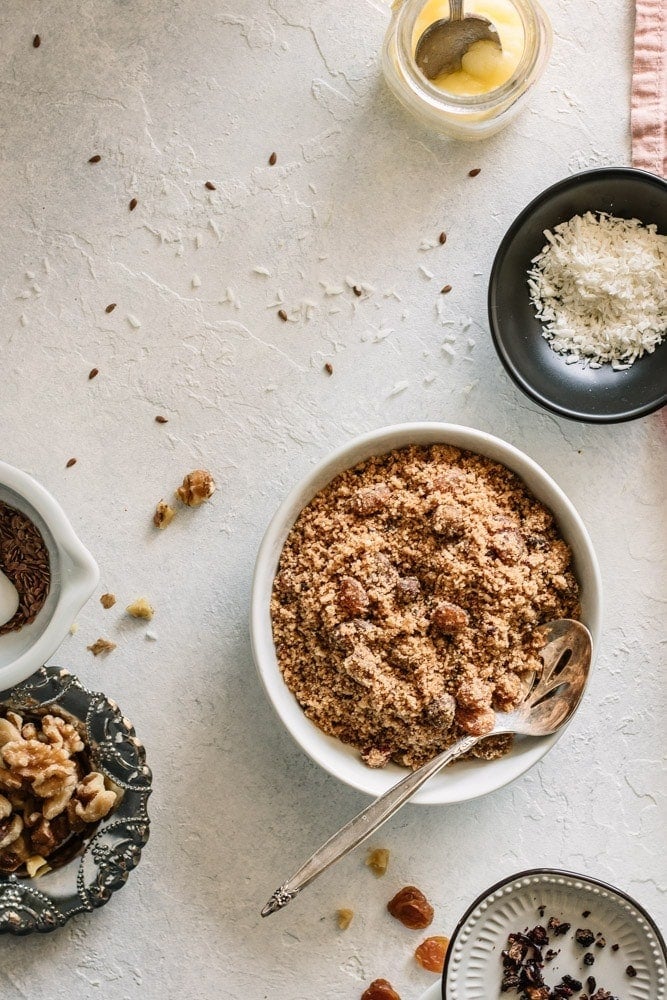
Want to save this post?
Enter your email below and get it sent straight to your inbox. Plus, get recipes & tips every week!
“Love love love the taste. Thank you so much for explaining it in such detail.”
Saba
What is Panjeeri?
Panjeeri (or Panjiri) is a tasty Pakistani/Indian postpartum healing and lactation food that is perfect for providing nourishment and energy to new moms. Since panjeeri is considered a ‘hot’ or warming food, it’s also eaten during winter to replenish and strengthen the body.
Though panjeeri recipes vary based on region and family, this is a long-standing, traditional version made with a base of ghee, whole wheat atta flour, semolina (sooji), dried fruit, nuts, and seeds.
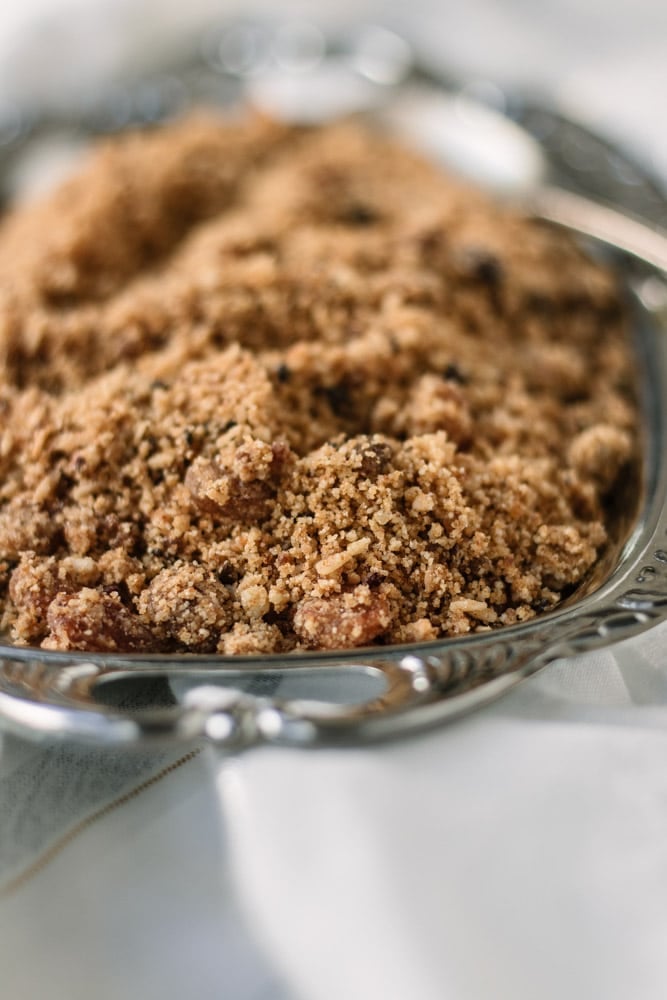
Panjeeri – A Traditional Healing Food
If you’ve been following this blog, you know I truly believe in traditional South Asian food wisdom. Our ancestors may not have studied the compounds of food in laboratories, but they observed the effects it had on their bodies. Using that wisdom, they made food that was healing, nourishing, and appropriate for individual needs and requirements.
Labor is very taxing to the body. In Western culture, it’s often overlooked how much healing women really need. That’s why I turn to traditional ayurvedic foods that consider the postpartum nutritional needs of recovering and nursing women.
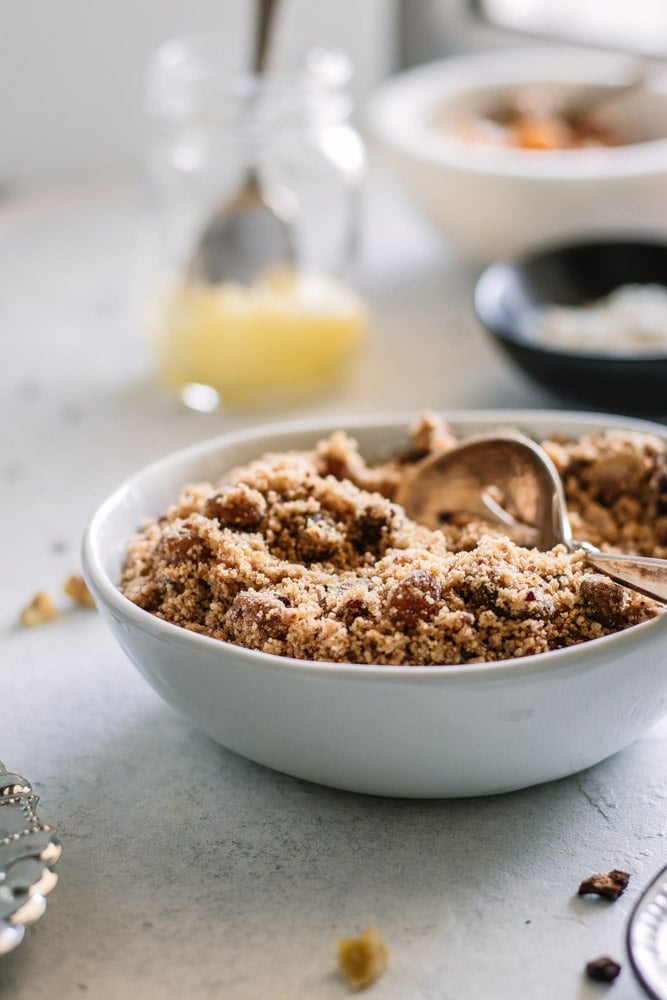
Panjeeri is similar to muesli or granola, except next-level healthy (proudly biased opinion) making it a nutritious snack. It’s a mashup of whole-wheat flour (atta), fine semolina, nuts, seeds, and herbs. You basically roast the entire South Asian/superfood section of your pantry in ghee, mix it all up, and you’ve got panjeeri!
Panjeeri Ingredients
Sourcing the ingredients for making Panjeeri may seem harder than making the Panjeeri itself. You can find edible gum (goond), flame of the forest (kamarkas), fox nuts (phool makhana), and powdered jaggery (gur) in many South Asian grocery stores (try calling before making the trip) or online, but feel free to omit the ingredients you can’t find. Here they are:
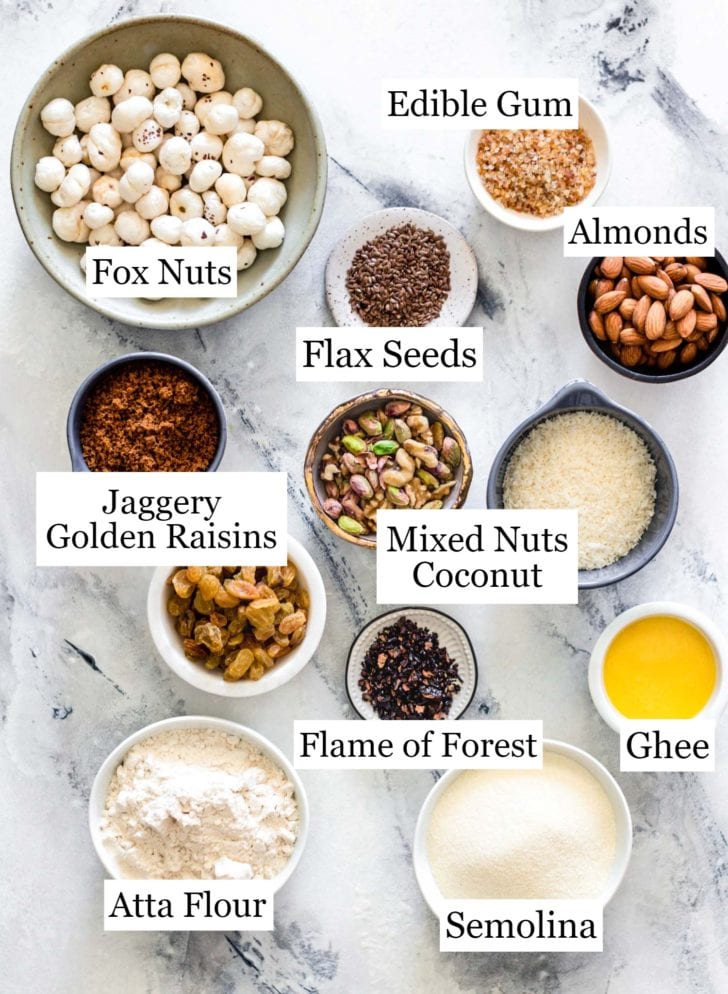
Clockwise From left:
- Fox Nuts (Phool Makhana) – Also called puffed lotus, these are lightweight, popcorn-like puffs. Raw phool makhana will not not break if you bite into it. When cooked, it’ll be crispy and break apart easily once you bite into it. Note that these absorb a lot of oil, so you don’t need to add more unless you want to. These take the longest to roast.
- Flax Seeds – Available in most grocery stores. Feel free to substitute with flax meal if that’s what you have on hand. I’ve used 1 tbsp here but you can use more if you’d like.
- Edible Gum (Goond) – This is an edible gum (often called gum arabic) derived from a tree sap and is said to be warming and strengthening for the body. As the gum crystals cook, they’ll pop and swell to about double the size. Do not use whole form crystals (Goond Katira) which are large crystals (very difficult to pulverize!).
- Nuts – I use raw almonds and walnuts or any other nuts I have in my pantry such as pistachios or cashews.
- Coconut – You can use any type of coconut flakes. Note that the consistency of the coconut will affect cook time.
- Ghee – Ghee is vital in Panjeeri. Be generous with it. It’s what makes the Panjeeri easy to eat and digest. Too little ghee makes panjeeri a bit dry and hard to down.
- Semolina (Sooji) – For better texture, choose fine semolina instead of coarse. If you can’t find it, coarse semolina will do just fine.
- Atta Flour – Instead of dry-roasting, I’ve tried roasting the atta in 4 tbsp ghee for the same amount of time. I found it makes for a heavier, ghee-laden panjeeri. Adding the atta dry adds balance. You can also substitute more semolina in place of atta.
- Golden Raisins – These add sweetness and texture to the panjeeri. If you add more, you may eed less sugar.
- Jaggery Powder (Gud) – Use jaggery powder, brown sugar, raw cane sugar, or a blend of sugars.
- Flame of forest (Kamarkas) – Literally translated to ‘tighten waist’, this is said to be especially beneficial to new moms. I’ve started with modest amount because I’m not a fan of the texture, but feel free to use more.
Tips for Making Panjeeri
- The key to roasting everything well is to keep the heat at medium or below and be patient with it. You want to remove any rawness from the ingredients so that it brings out the flavor and health-giving properties. But over-roasting will cause the nuts, seeds, etc. to become bitter.
- Try not to over-process the nuts and edible gum once they’re roasted. If you blend them too long, you’ll get a nut-butter consistency. For panjeeri, we want a grainy consistency.
- Clean off the pan as you go. If you find bits of the ingredients are sticking to the bottom, wipe your pan with a paper towel or rinse it. Then return to heat and continue cooking.
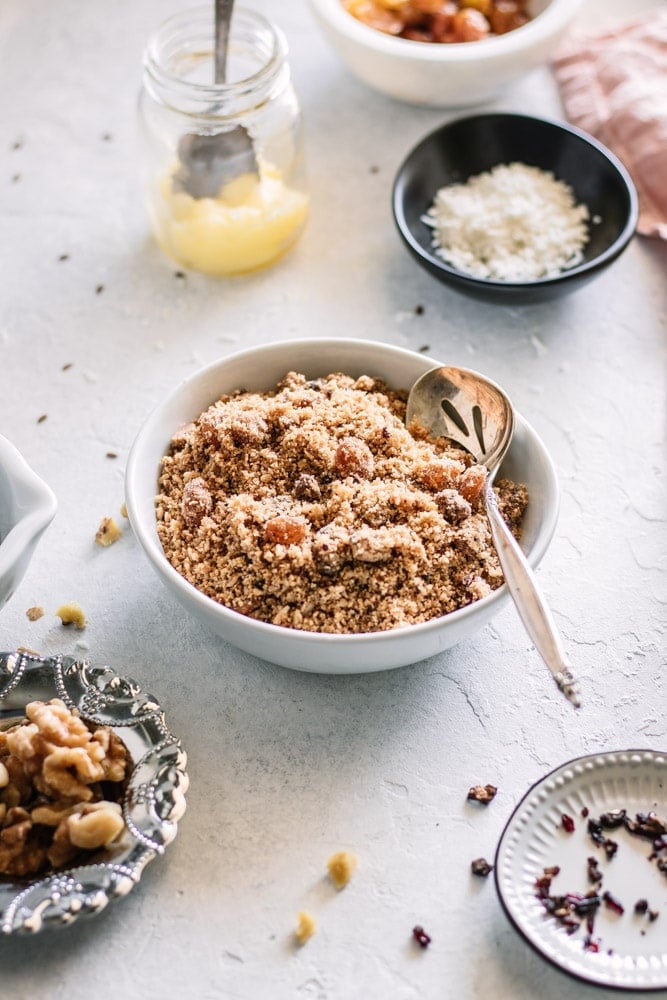
Tips for Eating & Storing Panjeeri
- Eat panjeeri in moderation. A tablespoon here, a small bowl there. It’s caloric (in the best way), nutrient-dense, and filling, so a little goes a long way. Keep it on your bedside and snack on it whenever the mood strikes, which will be often because it’s so tasty!
- This is not a doctor’s note but I believe since Panjeeri is a ‘warming’ food and is said to clear out the uterus, it should not be eaten in large quantities if you are pregnant or may be pregnant.
- Store panjeeri in an airtight container at room temperature and consume within 4 weeks. You can also freeze it immediately after making and then thaw at room temperature when ready to use.
Variations: For a gluten-free version, I would substitute ground lentils and chickpea flour (called gram flour or besan in Urdu/Hindi) for the semolina and whole wheat (atta). For a vegan panjeeri, substitute the ghee with coconut oil.
Other ingredients you can use include melon seeds, pumpkin seeds, cardamom powder, ginger powder, and fennel seeds.
More Traditional Recipes You’ll Love
- Authentic Turmeric Milk (also great for new moms)
- Pakistani Chai
- Semolina (Sooji) Halwa
I truly hope and pray this recipe benefits new moms and anyone looking to strengthen their bodies. If you try this recipe, don’t forget to leave a comment below! If you’re on Instagram, please tag me so I can see your creations. Thank you!
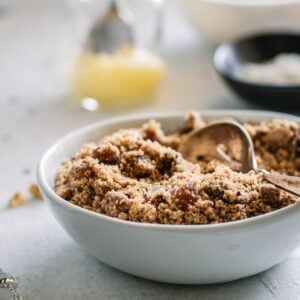
Panjeeri – Postpartum Healing and Lactation Recipe
Watch the Video
Ingredients
- ghee, as needed – be generous!
- 2/3 cup (100 g) raw almonds
- 1/2 cup (50 g) raw walnuts, pistachios, or cashews, or a combination of nuts
- 2-3 tbsp (25-40 g) edible gum (goond), use fine crystals
- 1 1/2-2 cups (~25 g) fox nuts (phool makhana)
- 2/3 cup (90-100 g) golden raisins
- 2/3 cup (55-65 g) desiccated coconut/coconut flakes
- 2-3 tbsp flax seeds or flax meal
- 1-2 tbsp (20 g) flame of forest (kamarkas), plus more, if desired
- 3/4 cup (150 g) fine semolina (sooji)
- 1 cup (120 g) durum whole wheat Atta flour
- 1/2 cup (~70 g) powdered jaggery, organic cane sugar, or a mix of both, plus more to taste
Instructions
- Heat a large nonstick pan or skillet over low-medium heat. Once hot, heat 2 tbsp ghee and add the almonds. Roast for 4 minutes, until they are lightly golden and smell nutty. Use a slotted spoon to remove the almonds and place in a medium bowl. Next, add the walnuts or mixed nuts to the pan. Roast for 2-3 minutes until lightly golden. Remove and set aside in the same bowl as the almonds. Be careful not to over-roast because the nuts may become bitter. Wipe pan, if needed. (See Note 1)
- Heat another 2 tbsp of ghee and add the edible gum crystals (goond). Roast, stirring often, for 4-5 minutes. The edible gum crystals will look crisp and swell to almost double in size. Remove and set these aside along with the nuts (you will be grinding these together later in a food processor). Clean the pan as needed.
- Heat 3 tbsp of ghee and add the fox nuts (phool makhana). Roast for 10 minutes, until they turn slightly golden and crispy. (See Note 2 to check for doneness.) Remove onto a small plate or bowl.
- Lower the heat to low and heat 1 tbsp of ghee. Add the raisins and roast for 2 minutes, until they puff up and begin to change color. Remove and place into a large bowl which will house all Panjeeri ingredients.
- Still on lowered heat, add the coconut flakes and lightly toast them for 1-2 minutes, or until they smell coconutty and and turn lightly golden. Add the flax seeds to the coconut flakes and stir to mix. Remove and transfer to the large bowl with the raisins.
- Raise the heat back up to medium and heat 2 tbsp of ghee. Add the flame of forest (kamarkas) toast for 2-3 minutes, until it has a red hue. Remove and add it to the large bowl with the raisins and coconut.
- Heat 3 tbsp of ghee and add the semolina. Stir the semolina, frequently at first and more continuously toward the end so that it roasts evenly. Roast for 10-12 minutes, or until it turns golden. Remove from heat and place into the large bowl. Clean off the semolina and ghee from the pan.
- Without adding ghee, add the whole wheat (atta) to the pan. Stir the atta, frequently at first and more continuously toward the end so that it roasts evenly. Dry-roast for at 17-20 minutes, or until the atta turns golden and starts to release a nutty aroma. You want to ensure it's fully cooked. Remove from heat and set aside into the large bowl.
- In a food processor, add the mixed nuts and edible gum crystals (from Steps 1-2) into the food processor and pulse to chop until they have a coarse, crunchy consistency. You want these to be grainy but not fine like a powder or processed to the point of a nut-butter consistency. Remove and add to the large bowl. Add the fox nuts (phool makhana) and pulse to chop until they have a coarse, crunchy consistency. Remove and transfer to the large bowl.
- Mix to combine all the prepared ingredients (atta flour, semolina, mixed nuts & edible gum, fox nuts, raisins, coconut & flax seeds, flame of forest, edible gum). Add the powdered jaggery/cane sugar and mix it again. Taste and adjust sweetness, as desired. If you feel that the mixture is dry or hard to down, feel free to add ghee. Allow to cool. Store in an airtight container in a cool, dry place.
Notes


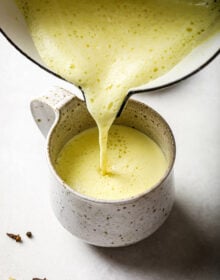

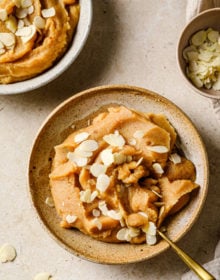
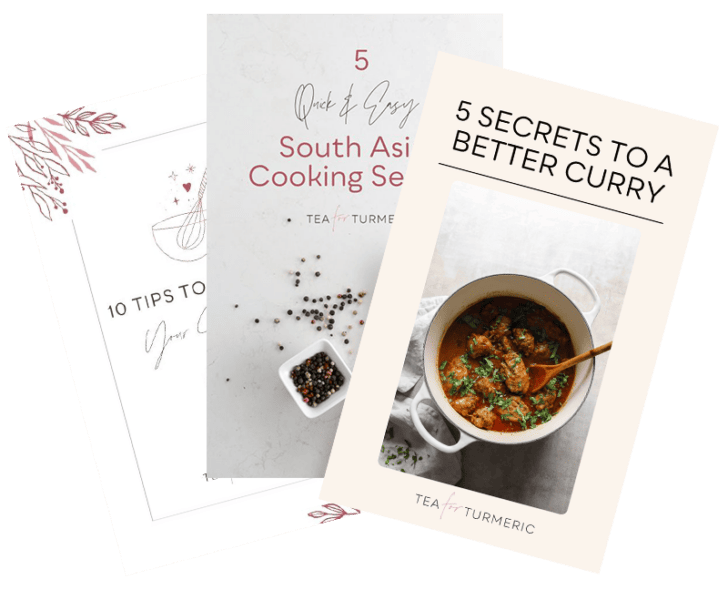
64 Comments on “Panjeeri – Postpartum Healing and Lactation Recipe”
I will definitely be trying this after giving birth! Are there any other recipes you have that are for healing and postpartum?
Hi Maria, Turmeric Milk is also great for new moms!
Thanks for Share this information with me really helpful for me.
That’s great to hear Ashish!
Hi 😊
I was once gifted this but in balls? Do you know what to add (if anything) to make
It into balls?
Thank you
Hello! Yes – those are called Pinni. My mother-in-law made them for me when my son was born – so delicous! I think you’ll need to use a different, finer flour (ex. moong dal flour) instead of semolina. Also, you’ll need a lot more ghee, so that it has enough moisture to form into balls. Hope that helps!
Just made this for myself. And it tastes great. Made panjeeri for the first time in my life and so happy with the results.
I also tried it without sugar and must say that if someone wants to leave the sugar out, he/she can do so and the panjeeri would still taste great. 👍
Thanks for this recipe.
That’s great to hear Ayesha! Thank you for sharing 🙂
In Panjeeri recioe u have this note
1/2 cup (~70 g) powdered jaggery, organic cane sugar, or a mix of both, plus more to tasteĺ
Do u mean 1/2 cup -70grams
What does -70mean ?? Confusing
Thank u
Hi Jen, SIt is 1/2 cup OR about 70 grams. It is not -70g but ~70g. The ~ means approximately. Hope that clears up any confusion 🙂
I just made this for my wife who gave birth to our first child 5 days ago. Thank you for the recipe!
She has to eat gluten-free, so I swapped GF oats for the semolina and gram flour for the atta whole wheat flour. Nothing seems to be worse for the switch. It’s a bit of a “made with love” process, yet very easy. It was fun to use some first-time ingredients in my growing Indian pantry.
It’s very toasty-tasting and seems very comforting. She said she likes it, so that’s a win!
Congratulations on the new addition to your family! We are so happy that your wife enjoyed the panjeeri!